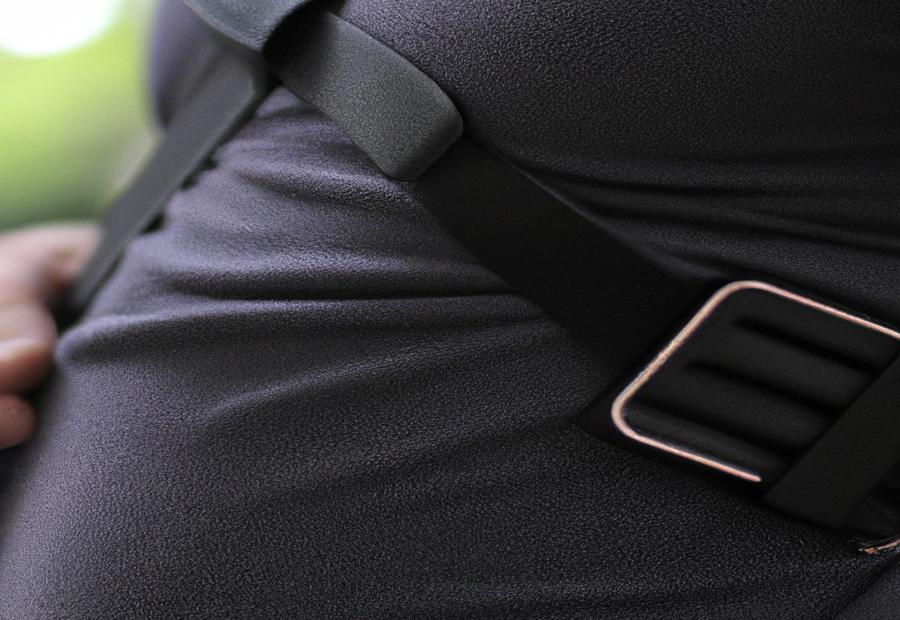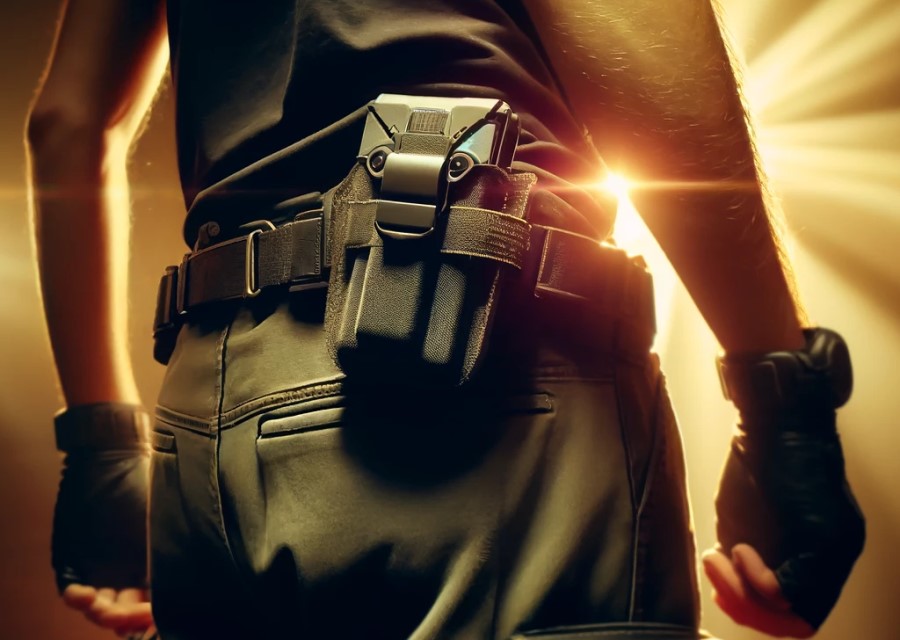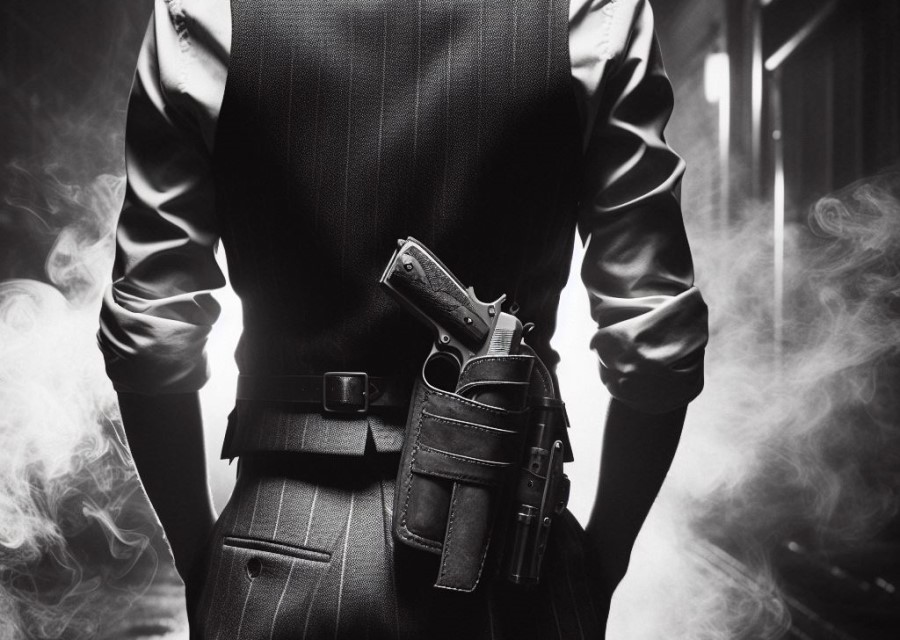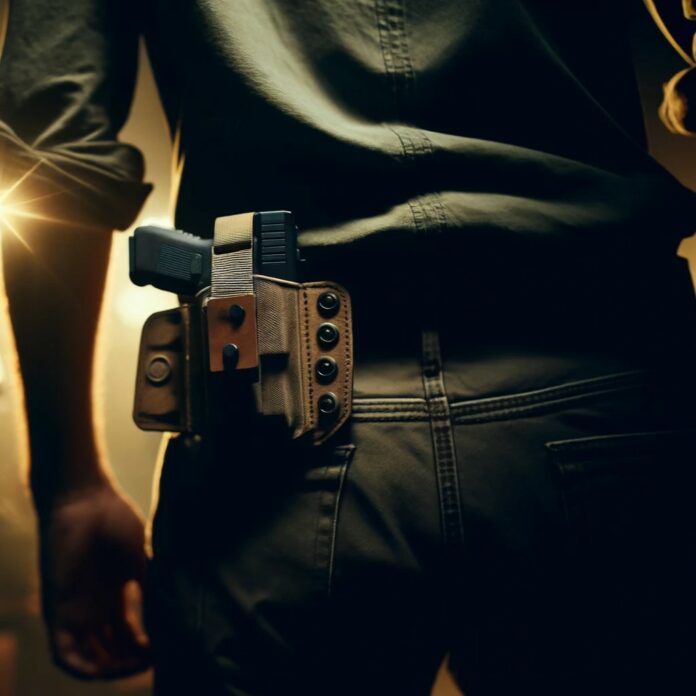Wearing a small back holster can provide a practical and discreet way to carry a firearm. This type of holster is designed to be worn at the lower back, offering advantages such as concealment, quick access, comfort, and versatility.
However, before using a small back holster, there are several considerations to keep in mind. These include firearm size and weight, physical limitations, and clothing choice. To ensure safe and proper use, it is crucial to follow the correct steps for wearing a small of back holster.
This includes choosing the right holster, identifying the perfect position, safely drawing and re-holstering, and practicing and familiarizing yourself with the holster.
There are tips to ensure safe usage of a small back holster. Understanding these guidelines will help you effectively and safely utilize a small of back holster for carrying your firearm.
Advantages of Small Back Holsters

Photo Credits: Paintballbuzz.Com by Keith Clark
Discover the game-changing benefits of small of back holsters! From enhanced concealment to quick access, comfort, and versatility, these sub-sections will reveal how this holster style revolutionizes your carry experience.
Say goodbye to bulky holsters and hello to a sleek and efficient way to secure your firearm. Whether you’re looking for maximum concealment or a practical carry solution, explore why small of back holsters are the top choice for self-defense enthusiasts.
Concealment
When using a small of back holster for carrying your firearm, concealment is an important factor to consider. Here are some points to keep in mind:
- Proper positioning: Positioning the holster correctly is crucial for effective concealment. It should be placed in the small of your back, aligning with the curve of your spine.
- Clothing choice: The type of clothing you wear can significantly impact concealment. Opt for looser-fitting shirts or jackets that can help hide the holster and firearm.
- Holster design: Choosing a holster with a slim profile and minimal printing will enhance concealment. Look for holsters specifically designed for small of back carry.
- Firearm selection: The size and shape of your firearm will also affect concealment. Compact or subcompact pistols are generally easier to conceal in a small of back holster.
- Movement: Be mindful of your movements to avoid printing or accidentally exposing your firearm. Practice maintaining proper concealment during various activities.
Remember, concealed carry requires responsibility and adherence to local laws and regulations. Always prioritize safety and proper training when using a small of back holster for concealed carry.
Quick Access
When it comes to quick access to your firearm, using a small of back holster is crucial. Here are the steps to ensure quick access:
- Choose a high-quality small of back holster that securely holds your firearm.
- Position the holster at the small of your back, ensuring a comfortable fit for quick access.
- Practice drawing and re-holstering your firearm safely and efficiently to ensure quick access.
- Familiarize yourself with the specific movements necessary for quick access to your firearm.
By following these steps, you can ensure that you have the ability to quickly access your firearm when needed. Remember to always prioritize safety and practice regularly to enhance your proficiency in quick access.
Comfort
Small back holsters prioritize comfort for users during concealed carry. The design of these holsters is specifically engineered to provide maximum comfort, ensuring a pleasant experience for users throughout the day.
The materials used in their construction contribute to their comfort, with soft padding and high-quality fabrics utilized to prevent any discomfort or irritation against the body.
Additionally, the ergonomic shape of the holster allows for a natural fit against the curve of the lower back, promoting comfort during movement.
Moreover, a properly fitted small of back holster distributes the weight of the firearm evenly, preventing any strain on the back and ensuring long-lasting comfort throughout extended periods of wear.
The positioning of the holster on the lower back enables easy accessibility without compromising comfort, allowing users to access the firearm swiftly and efficiently when needed.
By prioritizing comfort, small of back holsters provide a reliable and comfortable concealed carry option for individuals seeking both convenience and peace of mind. Users can confidently carry their firearms for extended periods without experiencing any discomfort.
Versatility
The versatility of small back holsters makes them a popular choice among firearm enthusiasts. Here are some key reasons why:
- Concealment: Small back holsters provide excellent concealment, as they sit comfortably against the lower back, making it easy to keep your firearm hidden from view.
- Quick access: These holsters allow for quick and efficient access to your firearm. With proper training and practice, you can draw your weapon swiftly when needed.
- Comfort: Small of back holsters are designed to be comfortable to wear for extended periods. The ergonomic design ensures a snug fit against the body, reducing discomfort and fatigue.
- Small of back holsters can accommodate a wide range of firearm sizes and models, making them versatile for different needs and preferences. Whether you have a compact pistol or a full-size handgun, there is a small of back holster to suit your needs.
Considerations Before Using a Small Back Holster

Looking to rock a small of back holster? Before you strap it on, let’s dive into some key considerations.
We’ll discuss how firearm size and weight, physical limitations, and clothing choices play into your decision-making process.
Get ready to make an informed choice and find the perfect fit for your concealed carry needs!
Firearm Size and Weight
To determine the suitability of a small of back holster, it is crucial to consider the size and weight of the firearm. Different firearms vary in their dimensions and mass, and this can affect the comfort and ease of carrying with a small of back holster.
The dimensions of the firearm determine its overall size and may affect how it fits and conceals in a small of back holster. Similarly, the weight of the firearm can influence the comfort and balance when carrying it in this type of holster. A heavier firearm may put more strain on the lower back and potentially cause discomfort over extended periods.
It is important to choose a small of back holster that is specifically designed to accommodate the size and weight of your firearm. Ensuring a proper fit will enhance comfort, concealment, and the overall safety of carrying your firearm.
Physical Limitations
To properly consider the physical limitations of using a small of back holster, it is important to assess one’s individual capabilities and restrictions.
Different individuals may have varying degrees of physical limitations that can affect their ability to effectively and safely use a small of back holster.
| Physical Limitation | Considerations |
| Back Issues or Injuries | Individuals with back problems, such as chronic pain or previous injuries, should consult with a healthcare professional to determine if carrying a firearm in a small of back holster is suitable for them. They should consider the potential strain and discomfort that may arise from the additional weight and pressure on their back. |
| Mobility Impairments | Individuals with limited mobility, such as those using mobility aids or experiencing mobility restrictions, should assess their ability to access and draw a firearm from a small of back holster. They should consider their range of motion, strength, and dexterity in their assessment. |
| Balance Issues | Those with balance issues, such as elderly individuals or individuals with certain medical conditions, should be cautious when using a small of back holster. The additional weight on the back may affect their balance and stability, potentially increasing the risk of falls or accidents. |
It is vital for individuals with physical limitations to prioritize their safety and well-being when considering the use of a small of back holster.
They should consult with professionals, such as healthcare providers or trainers, to determine the best option for carrying a firearm that accommodates their specific needs and limitations.
Clothing Choice
When selecting the right clothing choice to wear with a small of back holster, it’s crucial to prioritize comfort, concealment, and ease of access.
- Tight-Fitting Clothing: Opt for attire that fits snugly against your body to minimize printing and maintain the holster securely in place.
- Long Shirts or Jackets: Longer garments provide improved coverage and concealment for both the holster and firearm.
- Avoid Baggy or Loose Clothing: Steer clear of oversized clothing as it can hinder swift and smooth firearm retrieval. Loose attire also increases the risk of the holster shifting or the firearm becoming visible.
- Avoid Thick or Heavy Fabrics: Bulky fabrics add unnecessary weight and discomfort. It’s advisable to choose lightweight materials that allow for better flexibility and movement.
- Consider Concealed Carry Clothing: Some brands offer specialized clothing catered for concealed carry, featuring built-in holsters or reinforced pockets. These options provide enhanced comfort, concealment, and quick access.
- Choose Neutral Colors: Selecting neutral colors like black, gray, or navy helps blend well with various outfits and minimizes attention.
- Practice Drawing with Different Outfits: Experiment with different clothing options to ensure a smooth and reliable draw. Consider factors such as holster position and ease of accessibility for each outfit.
By carefully considering your clothing choice when wearing a small of back holster, you can ensure better concealment, comfort, and ease of firearm access when necessary.
Step-by-Step Guide on How to Wear a Small Back Holster

Looking to master the art of wearing a small of back holster? Look no further! In this section, we’ll guide you through the proper way to wear a small of back holster, step by step.
From selecting the right holster to identifying the perfect position, drawing and re-holstering safely, and even practicing for familiarity – we’ve got you covered. Get ready to enhance your holster-wearing skills like a pro!
Step 1: Choose the Right Holster
To choose the right holster for a small of back carry, follow these steps:
- Consider the Firearm Size and Weight: Select a holster that is specifically designed to accommodate the size and weight of your firearm. The holster should provide a secure fit to ensure your firearm stays in place.
- Evaluate the Retention System: Look for a holster that has a reliable retention system. This can be in the form of a thumb break strap, adjustable tension screws, or a retention hood. It is important to choose a holster that keeps your firearm securely in place, even during physical activity.
- Assess the Comfort and Concealment: Opt for a holster that is comfortable to wear for extended periods. Look for features such as padded backing or adjustable cant angles to ensure a comfortable fit. Additionally, consider the level of concealment the holster provides. It should easily hide your firearm under clothing to maintain a low-profile carry.
- Verify the Holster Material: Choose a holster made from durable and high-quality materials such as Kydex, leather, or nylon. The material should be able to withstand daily wear and tear and provide adequate protection for your firearm.
- Test the Draw Speed and Accessibility: Ensure that the chosen holster allows for a quick and efficient draw. It should allow easy access to your firearm when needed while also keeping it securely in place during regular activities.
When selecting a holster, prioritize safety, comfort, and accessibility. Consider your firearm’s specifications, personal preferences, and the specific carry needs to make an informed decision.
Remember to practice drawing and re-holstering your firearm regularly to become familiar with the chosen holster and ensure safe handling.
Step 2: Identify the Perfect Position
To properly identify the perfect position for wearing a small of back holster, follow these steps:
- Stand in front of a mirror and place the holster in the small of your back.
- Adjust the angle of the holster by tilting it slightly forward or backward until it feels comfortable.
- Experiment with different heights by raising or lowering the holster until it sits securely against your back without digging into your spine.
- Consider your dominant hand and determine whether you prefer a cross-draw or straight draw position. Ensure that the grip of the firearm is easily accessible from your preferred position.
Once you have identified the perfect position for your small of back holster, keep the following suggestions in mind to ensure a safe and comfortable experience:
- Always practice drawing and re-holstering your firearm in a safe and controlled environment until you are familiar and confident with the process.
- Ensure that the holster is securely attached to your belt or waistband to prevent it from shifting or moving while you are carrying.
- Regularly check the condition of your holster and replace it if any signs of wear or damage are present to maintain its reliability and effectiveness.
- Be aware of your surroundings and consider the situation before drawing your firearm, ensuring that it is necessary and appropriate.
Step 3: Draw and Re-holster Safely
To safely draw and re-holster your firearm when using a small of back holster, follow these steps:
- Establish a secure grip on your firearm with your dominant hand.
- Use your non-dominant hand to lift up your garment and clear it away from the holster.
- Use your dominant hand to firmly and smoothly draw the firearm from the holster, maintaining control of the muzzle direction at all times.
- Keep your finger indexed along the slide or frame of the firearm, away from the trigger, until you are ready to shoot.
- To re-holster, make sure your finger is off the trigger and the muzzle is pointing in a safe direction.
- Slowly and carefully insert the firearm back into the holster, ensuring it is fully seated and secure.
It is crucial to practice these steps regularly to become proficient and develop muscle memory. Always adhere to all applicable firearm safety rules and guidelines to prevent accidents and promote responsible gun ownership.
Step 4: Practice and Familiarize Yourself
- Practice drawing your firearm from the small of back holster in a safe and controlled environment.
- Familiarize yourself with the proper technique and form for a smooth and swift draw.
- Re-holster your firearm with caution, ensuring it is securely and properly positioned in the holster.
- Repeat the drawing and re-holstering process multiple times to build muscle memory and improve your speed and accuracy.
- Gradually increase the difficulty of your practice by incorporating movement and timed drills.
- Focus on mastering the fundamentals of drawing and re-holstering before attempting more advanced drills or scenarios.
- Regularly practice and maintain your proficiency with the small of back holster to ensure readiness and confidence in real-world situations.
Tips for Safely Using a Small of Back Holster
When using a small of back holster, it is important to prioritize safety. Here are some tips for safely using a small of back holster:
- Positioning: Ensure that the holster is positioned in the small of your back, where it can be easily reached and retrieved without straining.
- Secure fit: Make sure that the holster securely holds your firearm in place to prevent accidental dislodging.
- Proper draw technique: Practice drawing your firearm from the small of back position to ensure a smooth and efficient draw in a self-defense situation.
- Avoid bending or twisting: Be mindful of your movements and avoid excessive bending or twisting, as it can cause discomfort or compromise the position of the holster.
- Situational awareness: Stay aware of your surroundings and avoid situations where someone could easily access your firearm from behind.
- Regular maintenance: Regularly clean and inspect your holster to ensure that it is functioning properly and free from any obstructions or defects.
- Training and practice: Obtain proper training on the use of holsters and practice your draw technique regularly to improve your proficiency and confidence.
By following these tips for safely using a small of back holster, you can safely use a small of back holster and be prepared to protect yourself if necessary.
Frequently Asked Questions
How should I position my hand when carrying a small of back holster?
When carrying a small of back holster, it is recommended to use the palm-in grip angle. This grip angle is similar to strong-side carry and allows for a firmer grip on the weapon.
Does the small of back holster offer international shipping?
The availability of international shipping for small of back holsters may vary depending on the manufacturer or retailer. It is best to check with the specific company to see if they offer international shipping options.
What are the dominant carry positions besides the small of back carry?
There are several dominant carry positions besides the small of back carry. These include appendix carry, behind the hip carry, strong side carry, cross draw carry, and pocket carry. These alternatives are often considered safer and more accessible.
How can I find a comfortable sitting position when wearing a small of back holster?
Wearing a small of back holster can make finding a comfortable sitting position difficult, especially in a chair or car seat. It is important to experiment with different adjustments and holster positions to find the most comfortable option for your body type and preferences.
Is the arm motion different when drawing from a small of back holster?
Yes, drawing from a small of back holster involves a longer arm motion and tucking the hand behind the back. This can make the drawing motion less efficient and more complicated than other carry positions. It may require more training to overcome the challenges associated with this arm motion.
How can I maximize concealment when carrying a small of back holster?
To maximize concealment when carrying a small of back holster, it is recommended to use an inside-the-waistband (IWB) holster. This type of holster is designed to be hidden inside the waistband of your pants, providing better concealment than other holster options.

